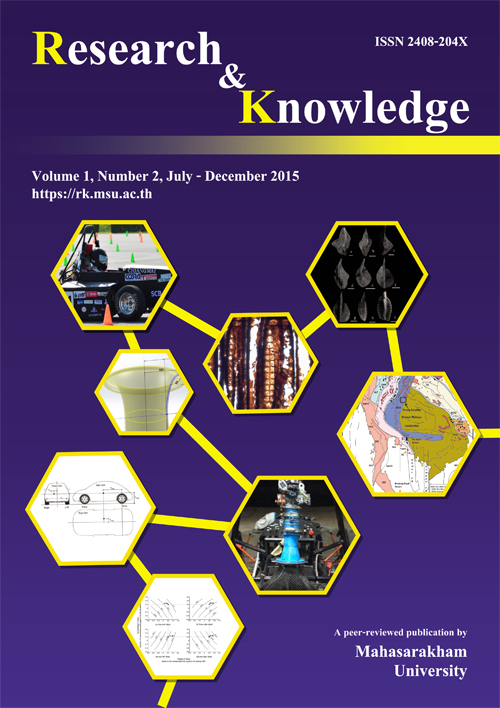Development of intake manifold for Student Formula CMU F-914 using theoretical and simulated designs
Keywords:
Intake manifold, restrictor, bellmouth, surge tank, runner, Student FormulaAbstract
The objectives of this study were to design, develop and construct an intake manifold for the Student Formula CMU F-914 race car, or the F-914, by using theoretical analysis together with simulation software and experimental verifi cation of the design results. Then to compare the pressure drop in the intake manifold of the F-914, which was designed in this study, and the intake manifold of the previous race car, the F-813. The designed intake manifold consisted of an ABS restrictor with the narrowest passage located at 25% of the restrictor’s length measured from the inlet, a carbon fi ber surge tank with internal volume of 1,558 cm3 , aluminum elliptical profi le bellmouths, and aluminum runners with a length of 102 mm. The experimental verifi cation showed that after the pressure drop across the throttle valve was considered in the simulation, the pressure drop from the simulation was almost the same as the one from the experiment for both intake manifolds. Moreover, it was found that the intake manifold of the F-914 had lower pressure drops than those of the F-813 by 43%, 94%, 66%, 69%, and 29% at engine speeds of 6,000, 7,000, 8,000, 9,000, and 10,000 rpm, respectively. Therefore, the theoretical and simulated designs presented in this study had acceptable reliability and they could be practically used for designing the intake manifolds.
References
Blair, G. P. and Cahoon, W. M. 2006. Special investigation: Design of an intake bellmouth. Race Engine Technology 17, 34-41.
Fox, R. W., Pritchard, P. J. and McDonald, A. T. 2010. Introduction to fl uid mechanics. 7th ed., John Wiley & Sons, USA, pp. 745.
Harrison, M. F., De Soto, I. and Rubio Unzueta, P. L. A. 2004. Linear acoustic model for multi-cylinder IC engine intake manifolds including the effects of the intake throttle. Journal of Sound and Vibration 278 (4-5), 975-1011.
Heisler, H. 1995. Advanced engine technology. Edward Arnold Publisher, UK, pp. 800. Incropera, F. P. and DeWitt, D. P. 2002. Introduction to heat transfer. 4th ed., John Wiley & Sons, USA.
Jemni, M. A., Kantchev, G. and Abid, M. S. 2011. Infl uence of intake manifold design on in-cylinder fl ow and engine performances in a bus diesel engine converted to LPG gas fueled, using CFD analyses and experimental investigations 36 (5), 2701-2715.
Kammuang-lue, N. and Chattanjai, T. 2012. Design of an intake manifold for the Student Formula CMU F-611. Proceedings of the Fourth International Conference on Science, Technology and Innovation for Sustainable Well-Being (STISWB IV), Thailand, pp. 112-120.
Sakowitz, A., Mihaescu, M., and Fuchs, L. 2014. Flow decomposition methods applied to the fl ow in an IC engine manifold. Applied Thermal Engineering 65 (1-2), 57-65.
Wang, J. 2011. Theory of fl ow distribution in manifolds. Chemical Engineering Journal 168 (3), 1331-1345.
Society of Automotive Engineers Thailand. 2015. 2014 SAE Student Formula Rules, Society of Automotive Engineers, USA. http://www.tsae.or.th.
Solid Works Flow Simulation. 2015. Dassault Systèmes SolidWorks Corperation, USA.http://www.solidworks. com/sw/products/simulation/fl ow-simulation.htm.
Downloads
Published
How to Cite
Issue
Section
License

This work is licensed under a Creative Commons Attribution-NoDerivatives 4.0 International License.








